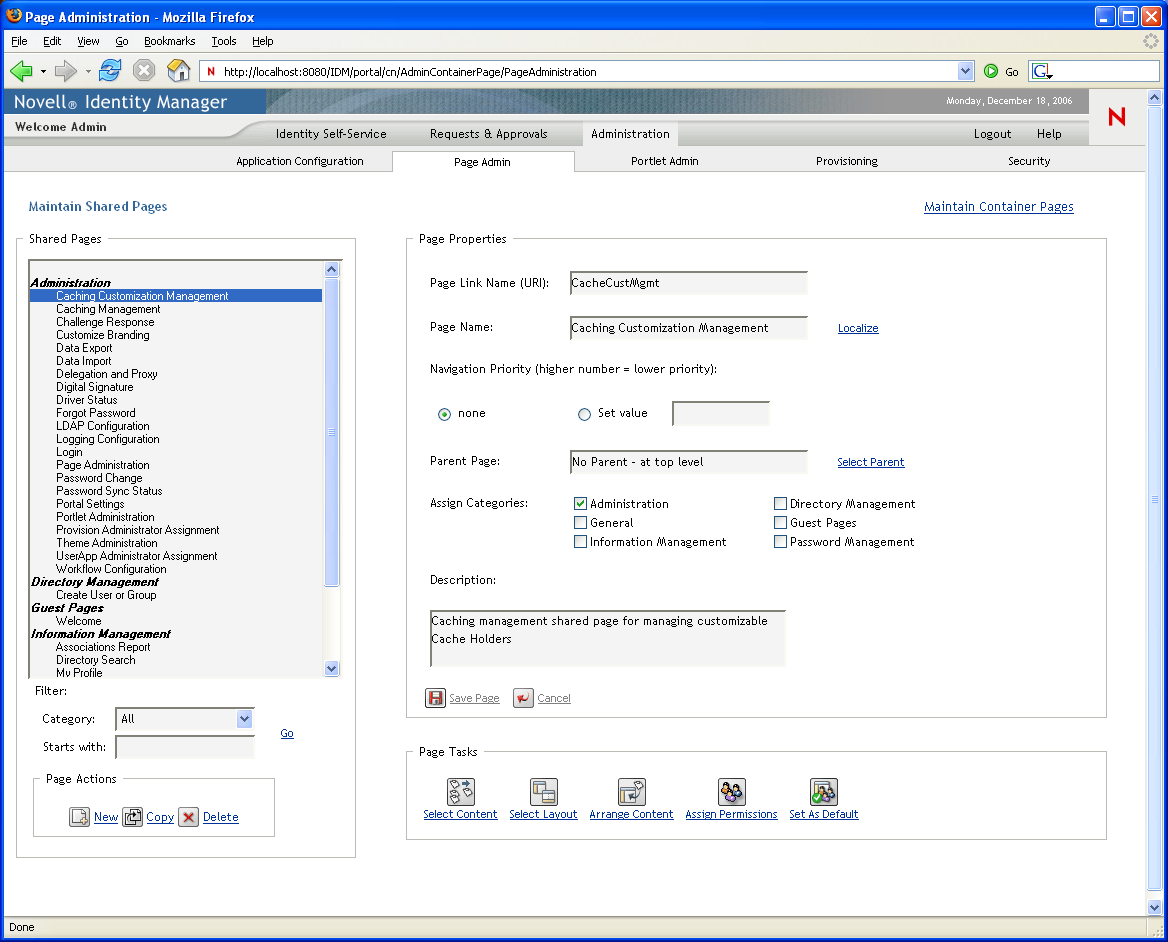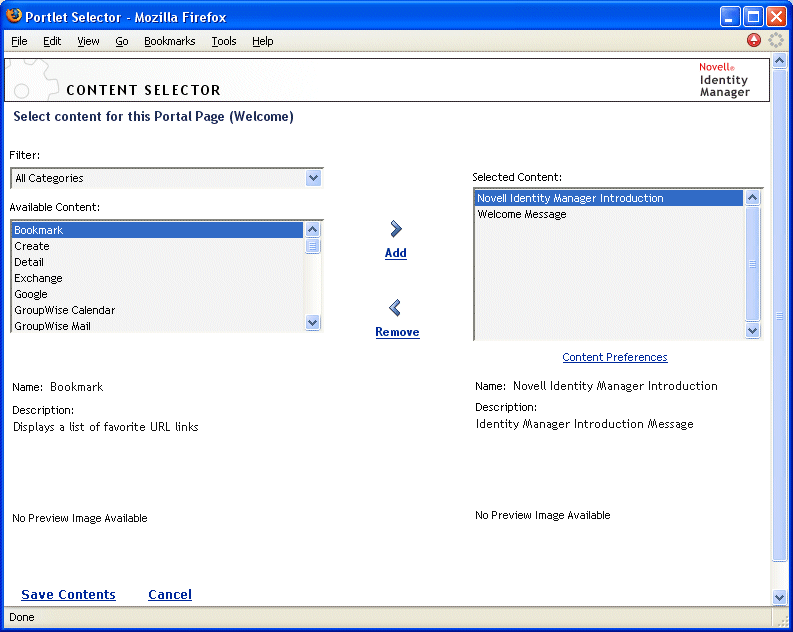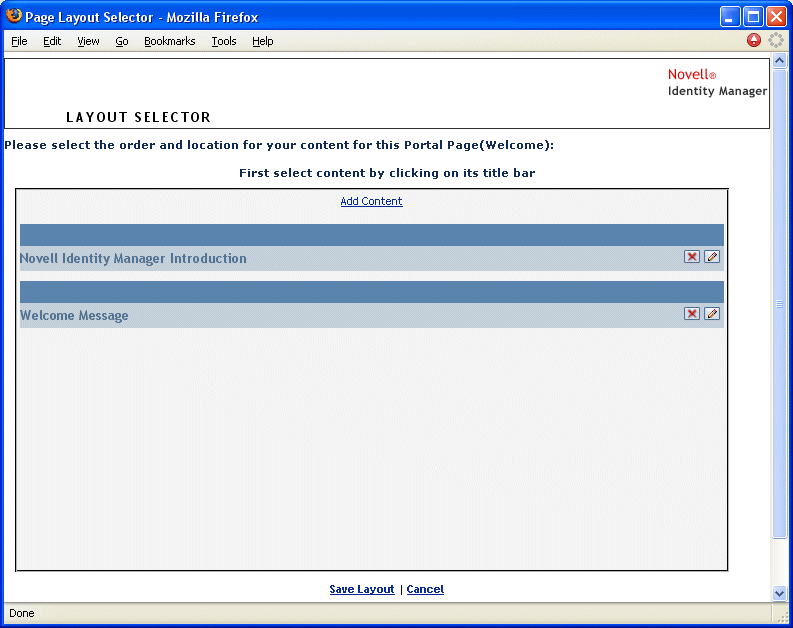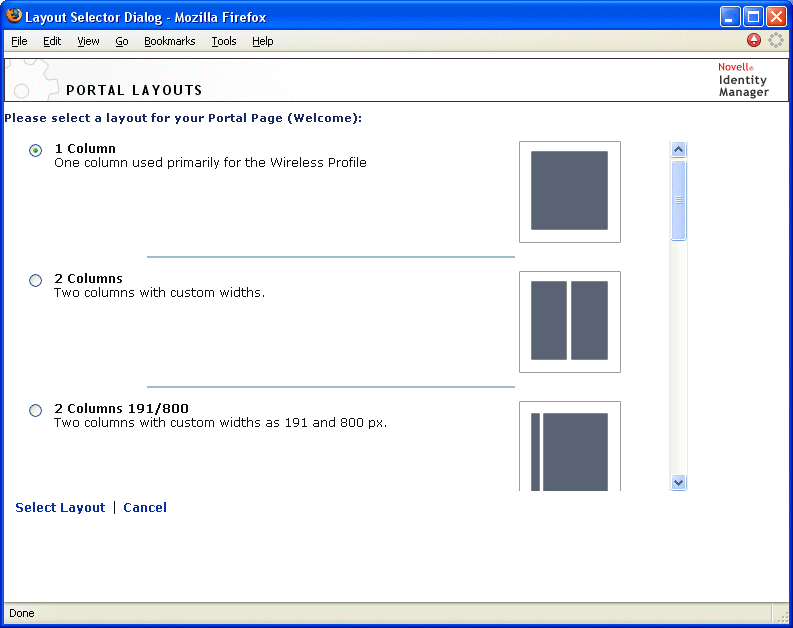6.3 Creating and Maintaining Shared Pages
The process of creating and maintaining shared pages involves the following steps:
-
Create a new shared page or select an existing shared page, as described in Section 6.3.1, Creating Shared Pages.
-
Add content (in the form of portlets) to the page, as described in Section 6.3.2, Adding Content to a Shared Page.
You might also want to delete content from the page, as described in Section 6.3.3, Deleting Content from a Shared Page.
-
Choose a portal layout, as described in Section 6.3.4, Modifying the Layout of a Shared Page.
-
Arrange the order and position of content on the selected layout, as described in Section 6.3.5, Arranging Content on the Shared Page.
-
Display the new page by entering the shared page URL in your browser, as described in Section 6.3.6, Displaying a Shared Page.
Shared Pages and Layouts
Shared pages are not tightly bound to portal layouts. That means you can switch layouts for shared pages without losing any page contents. When a new layout is applied, any portlets that have been added to the page are automatically displayed using the new layout. You might need to fine-tune the content placement in the new layout.
6.3.1 Creating Shared Pages
You can create shared pages from scratch or by copying existing pages. This section describes both procedures.
To create a shared page from scratch:
-
On the Page Admin page, select .
The Maintain Shared Pages panel displays:

-
Select the page action (in the bottom left section of the panel).
An untitled, uncategorized shared page is created.
-
Specify the page properties of the shared page:
Property
What to do
Page Link Name (URI)
Specify the URI name for the page (as it is to appear within the user interface URL). For example, if you specify the URI:
MySharedPage
it appears within the URL like this:
http://myappserver:8080/IDM/portal/cn/MyContainerPage/MySharedPage
Page Name
Specify the display name for the page. For example:
My Shared Page
You can click to specify localized versions of this name for other languages.
Navigation Priority
Specify one of the following:
-
if you don’t need to assign a priority to this shared page.
-
to assign a priority to this shared page, relative to other shared pages. The priority must be an integer between 0 and 9999, where 0 is the highest priority and 9999 is the lowest.
Setting priority values is useful if you want to ensure a particular order when pages are listed by priority, or if you want to ensure a particular selection when multiple default pages exist (in the case of a user who belongs to multiple groups).
Parent Page
If you want this shared page to be the child of another shared page, click . Make sure that both the parent and child pages belong to the (to prevent display problems).
At runtime, the end user sees this relationship when using the Shared Page Navigation portlet. When displaying the list of shared pages, it shows children indented under their parents.
Child pages do not inherit content, preferences, or settings from their parent pages. Conversely, parent pages do not automatically display the content of child pages along with their own content.
Assign Categories
Select zero or more of the following categories in which you want the page to belong:
-
Administration
-
Directory Management
-
General
-
Guest Pages
-
Information Management
-
Password Management
Assigning categories is useful if you want to ensure proper organization when pages are listed by category, or if you want to ensure an appropriate subset when pages are filtered by category.
NOTE: is a special category used to identify shared pages that can be displayed prior to user login but not after. For more information, see the section on the Shared Page Navigation portlet in Section 10.0, About Portlets.
Description
Type text that describes the page.
-
-
Click (at the bottom of the page properties section).
To create a shared page by copying an existing page:
-
On the Page Admin page, select .
-
In the list of shared pages, select the page you want to copy.
If the list is long, you can refine it (by category or starting text) to more easily find the desired page.
-
Select the page action (in the bottom-left section of the panel).
A new shared page is created with the name Copy of OriginalPageName.
-
Specify the page properties of the shared page as described in .
-
Click (at the bottom of the page properties section).
6.3.2 Adding Content to a Shared Page
After you create a shared page, the next step is to add content by selecting portlets to place on the page. You can use prebuilt portlets supplied with the Identity Manager User Application or other portlets you have registered.
-
Open a new or existing page on the Maintain Shared Pages panel, then click the page task (at the bottom of the panel).
The Content Selector displays in a new browser window:

-
If you want to display a specific category of available content, select a category from the drop-down list.
-
Select one or more portlets from the list.
Hold down the Ctrl key to select multiple non-contiguous portlets from the list; use the Shift key to make multiple contiguous selections.
-
Click to move your choices to the list.
-
You can click to edit the preferences of any portlet you have selected for your shared page. The preference values you specify take effect for the instance of the portlet that appears on your page.
-
Click .
Now that you have chosen the content for your shared page, you can select a new layout as described in Section 6.3.4, Modifying the Layout of a Shared Page, or arrange the content on the current layout as described in Section 6.3.5, Arranging Content on the Shared Page.
6.3.3 Deleting Content from a Shared Page
In the process of creating shared pages, you might want to delete content by removing portlets from a page. You can use the Content Selector or Layout Selector, as described in the following procedures.
-
Open a page on the Maintain Shared Pages panel, then click the page task (at the bottom of the panel).
The Content Selector displays in a new browser window as shown in Section 6.3.2, Adding Content to a Shared Page.
-
Select a portlet you want to delete from the list and click .
The portlet is removed from the page.
-
Click .
To delete content from a shared page by using the Layout Selector:
-
Open a page on the Maintain Shared Pages panel, then click the page task (at the bottom of the panel).
The Layout Selector displays in a new browser window, showing the portlets on that page:

-
Click the button for a portlet you want to remove.
-
When you’re prompted for confirmation, click .
The portlet is removed from the page.
-
Click .
6.3.4 Modifying the Layout of a Shared Page
When you modify the layout of a shared page, existing content is shifted to accommodate the new layout. In some cases, you might need to fine-tune the end result.
To modify the layout of a shared page:
-
Open a page on the Maintain Shared Pages panel, then click the page task (at the bottom of the panel).
The Portal Layouts list displays in a new browser window:

-
Scroll through the choices and select the layout you want.
-
Click .
6.3.5 Arranging Content on the Shared Page
After you have designated the content and layout for your shared page, you can position the content in the selected layout, add other portlets in specific locations, or delete portlets.
To arrange content on a shared page:
-
Open a page on the Maintain Shared Pages panel, then click the page task (at the bottom of the panel).
The Layout Selector displays in a new browser window, showing the portlets on that page:

-
If you want to add a portlet to the page:
-
Click in the desired layout frame.
The Portlet Selector displays in a new browser window.
-
If you want to display a specific category of available content, select a category from the drop-down list.
-
Select a portlet you want from the list.
-
Click .
The Portlet Selector closes and the portlet you selected appears in the target layout frame of the Layout Selector.
-
-
If you want to move a portlet to a different location in the layout, follow these browser-specific steps:
-
If you want to remove a portlet from the layout:
-
Click the button for the portlet you want to remove.
-
When you’re prompted for confirmation, click .
The portlet is removed from the layout.
-
-
If you want to edit the preferences of a portlet:
-
Click the pencil button for the portlet you want to edit.
The portlet’s Content Preferences display in your browser.
-
Change preference values, as appropriate.
The preference values you specify take effect for the instance of the portlet that appears on your page.
-
Click .
-
-
Click to record your changes and close the Layout Selector.
6.3.6 Displaying a Shared Page
To display your shared page, go to this URL in your Web browser:
http://server:port/IDM-war-context/portal/pg/shared-page-name
For example, to display the shared page named MySharedPage:
http://myappserver:8080/IDM/portal/pg/MySharedPage